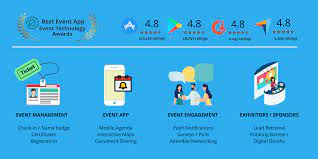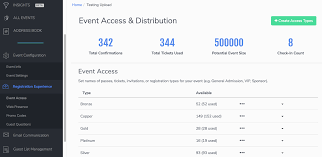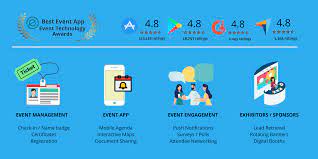Event Management Software Solutions: Streamlining Your Event Planning Process
In today’s fast-paced world, organizing and managing events can be a complex and demanding task. From conferences and trade shows to weddings and music festivals, event planners face numerous challenges in ensuring the success of their events. However, with the advent of event management software solutions, the process has become more streamlined and efficient than ever before.
Event management software is designed to simplify various aspects of event planning, execution, and evaluation. It offers a wide range of features that help organizers stay organized, save time, and enhance attendee experiences. Let’s explore some key benefits of using event management software solutions:
- Centralized Planning: Event management software provides a centralized platform where planners can manage all aspects of their event. From creating budgets and timelines to coordinating with vendors and stakeholders, everything can be conveniently organized in one place. This eliminates the need for multiple spreadsheets or manual tracking systems, reducing the chances of errors or miscommunication.
- Online Registration: With online registration capabilities, attendees can easily register for events through a user-friendly interface. Event management software allows organizers to create customized registration forms with options for ticket types, pricing tiers, discounts, and more. This not only simplifies the registration process but also enables real-time tracking of attendee numbers.
- Marketing and Promotion: Effective marketing is crucial for any successful event. Event management software often includes built-in marketing tools such as email campaigns, social media integration, and analytics tracking. These features help organizers reach their target audience more effectively while measuring campaign performance to make data-driven decisions.
- Attendee Engagement: Engaging attendees before, during, and after an event is essential for creating memorable experiences. Event management software offers interactive features like personalized agendas, networking tools, live polling, surveys, and mobile apps that keep attendees engaged throughout the event lifecycle.
- Resource Management: Efficient resource management is vital for smooth event operations. Event management software allows organizers to manage resources such as venues, equipment, staff, and catering. With real-time visibility into resource availability and automated scheduling capabilities, planners can optimize resource allocation and prevent conflicts.
- Data Analytics: Post-event evaluation is crucial for understanding event success and identifying areas for improvement. Event management software provides comprehensive analytics and reporting tools that capture attendee feedback, track event metrics, and measure ROI. This data-driven approach helps organizers make informed decisions for future events.
- Integration Capabilities: Event management software often integrates with other systems such as CRM platforms, marketing automation tools, payment gateways, and survey platforms. This seamless integration enables data synchronization across different systems, eliminating manual data entry and ensuring accurate information flow.
In conclusion, event management software solutions have revolutionized the way events are planned and executed. By providing a centralized platform for streamlined planning, online registration, marketing tools, attendee engagement features, resource management capabilities, data analytics options, and seamless integrations – these solutions empower event planners to deliver exceptional experiences while saving time and effort.
If you’re an event planner looking to enhance your efficiency and elevate your events to new heights of success, consider exploring the wide range of event management software solutions available in the market today.
7 Frequently Asked Questions About Event Management Software Solutions
- What features should I look for in an event management software solution?
- How much does event management software cost?
- How secure is event management software?
- What is the best event management software for my business needs?
- How easy is it to use event management software?
- What integrations are available with event management software solutions?
- What customer support options are available with event management software solutions?
What features should I look for in an event management software solution?
When selecting an event management software solution, it’s important to consider a range of features that will meet your specific needs. Here are some key features to look for:
- Online Registration and Ticketing: The software should offer a user-friendly online registration system that allows attendees to easily register and purchase tickets. Look for customizable registration forms, multiple ticket types, discount options, and secure payment processing.
- Event Website Builder: An integrated event website builder enables you to create a professional and branded event website without any coding knowledge. Look for customizable templates, drag-and-drop functionality, and the ability to add essential event details like schedules, speakers, and sponsors.
- Attendee Management: The software should provide tools for managing attendee data efficiently. Look for features like attendee tracking, contact management, badge printing capabilities, group registration options, and the ability to import/export attendee lists.
- Event Marketing and Promotion: Look for built-in marketing tools such as email campaigns, social media integration, promotional codes/discounts, and analytics tracking. These features help you reach your target audience effectively and measure the success of your marketing efforts.
- Agenda/Schedule Management: Ensure the software offers robust agenda or schedule management capabilities. Look for features like session/track management, speaker profiles/bios, session ratings/feedback collection, and personalized agendas for attendees.
- Exhibitor/Sponsor Management: If you have exhibitors or sponsors at your event, look for features that facilitate their management. This may include booth assignment/management tools, lead retrieval capabilities, sponsor recognition options on the event website or app.
- Onsite Check-In and Badge Printing: Look for mobile check-in functionality that allows you to quickly check-in attendees onsite using smartphones or tablets. Additionally, badge printing capabilities are essential to streamline the check-in process at larger events.
- Mobile App Integration: A mobile app can greatly enhance attendee engagement during the event. Look for software that offers mobile app integration or provides a native mobile app solution with features like personalized agendas, networking tools, interactive maps, and push notifications.
- Reporting and Analytics: The software should provide comprehensive reporting and analytics capabilities to measure event success. Look for features like attendance tracking, survey feedback collection, session popularity analysis, financial reporting, and ROI measurement.
- Integration Capabilities: Consider whether the event management software can integrate with other systems you use, such as CRM platforms, marketing automation tools, payment gateways, or survey platforms. Seamless integration ensures smooth data flow across different systems.
Remember to evaluate your specific requirements and prioritize the features that align with your event goals. It’s also beneficial to request demos or trials from different providers to assess how well the software meets your needs before making a decision.
How much does event management software cost?
The cost of event management software can vary depending on various factors such as the size and complexity of your events, the number of attendees, the features and functionality you require, and the specific software provider you choose.
Event management software typically offers different pricing plans based on your needs. Some providers offer tiered pricing models, where you pay based on the number of events or attendees you plan to manage. Others may offer a subscription-based model with monthly or annual fees.
Basic event management software plans can start at around $50 to $100 per month, offering essential features such as online registration, event website creation, and basic attendee management tools. As you move up to more advanced plans with additional features like marketing automation, custom branding, mobile apps, and complex integrations, the prices may increase accordingly.
For larger-scale events or enterprise-level solutions that cater to complex event requirements and extensive customization options, prices can range from several hundred dollars per month to several thousand dollars per year.
It’s important to carefully evaluate your specific needs and budget when selecting an event management software solution. Many providers offer free trials or demo versions of their software so that you can assess its suitability before committing to a purchase. Additionally, consider reaching out directly to software providers for detailed pricing information tailored to your specific requirements.
Remember that while cost is an important consideration, it’s equally crucial to focus on finding a solution that meets your unique event management needs effectively and efficiently.
How secure is event management software?
Event management software generally prioritizes security measures to protect sensitive data and ensure the privacy of both event organizers and attendees. However, the level of security can vary depending on the software provider and the specific features offered. Here are some common security measures implemented by reputable event management software solutions:
- Data Encryption: Most event management software employs encryption protocols to secure data transmission between users and servers. This ensures that any information exchanged, such as attendee registration details or payment information, is encrypted and protected from unauthorized access.
- Secure Payment Processing: Event management software often integrates with trusted payment gateways to handle financial transactions securely. These gateways adhere to industry standards for encryption and compliance, providing a secure environment for processing payments.
- Access Controls: To prevent unauthorized access, event management software typically incorporates role-based access controls (RBAC). This means that different users have varying levels of access rights based on their roles within the organization. For example, an event planner may have full administrative privileges, while a staff member may only have access to specific modules or functions.
- User Authentication: Robust event management software utilizes strong user authentication methods such as passwords, two-factor authentication (2FA), or biometric authentication to ensure that only authorized individuals can access sensitive data.
- Regular Updates and Patches: Software providers frequently release updates and patches to address any identified vulnerabilities or security issues. It is crucial for event organizers to keep their software up-to-date to benefit from these security enhancements.
- Data Backups: Reliable event management software often includes automated data backup features, ensuring that critical information is regularly backed up in case of system failures or data loss incidents.
- Compliance with Data Protection Regulations: Reputable event management software providers adhere to relevant data protection regulations such as the General Data Protection Regulation (GDPR) in the European Union or the California Consumer Privacy Act (CCPA) in the United States. They implement measures to protect personal data and give users control over their information.
While event management software providers strive to implement robust security measures, it is essential for event organizers to also take responsibility for maintaining the security of their events. This includes using strong passwords, educating staff on best security practices, and regularly reviewing access privileges.
Before selecting an event management software solution, it is recommended to thoroughly research the provider’s security features, read user reviews, and inquire about their data protection policies. Additionally, consulting with IT professionals or experts in the field can provide valuable insights into the software’s security capabilities.
What is the best event management software for my business needs?
Choosing the best event management software for your business needs depends on several factors, including the size and type of events you organize, your budget, and specific features you require. Here are a few popular event management software options that cater to different needs:
- Eventbrite: Eventbrite is a widely recognized platform suitable for organizing a variety of events, from small workshops to large conferences. It offers features such as online ticketing, event promotion tools, attendee management, and analytics.
- Cvent: Cvent is a comprehensive event management platform that caters to organizations planning large-scale conferences and trade shows. It provides tools for event registration, venue sourcing, attendee engagement, onsite check-in, and data analytics.
- Bizzabo: Bizzabo is known for its user-friendly interface and robust features. It offers event registration and ticketing capabilities, networking tools, agenda management, marketing integrations, sponsor management options, and post-event analytics.
- Eventzilla: Eventzilla is a cost-effective solution suitable for small to medium-sized events. It provides features like online registration forms, payment processing options, email marketing integrations, attendee check-in tools, and basic reporting functionalities.
- Aventri (formerly etouches): Aventri is an end-to-end event management platform that covers various aspects of event planning and execution. It includes features such as registration management, website creation tools, email marketing automation options, budget tracking capabilities, mobile apps for attendees, and robust reporting functionalities.
- Whova: Whova focuses on enhancing attendee engagement through its mobile app platform. It offers features like personalized agendas with session reminders, networking opportunities with chat functionality, live polling capabilities during sessions or presentations, exhibitor listings with interactive maps—alongside traditional event management functionalities like registration and ticketing.
It’s essential to thoroughly evaluate each software option based on your specific requirements before making a decision. Consider factors such as pricing, ease of use, scalability, customer support, and integration capabilities with other systems you may already use in your business. Additionally, reading reviews and seeking recommendations from other event planners can provide valuable insights to help you make an informed choice that aligns with your business needs.
How easy is it to use event management software?
Event management software is designed to be user-friendly and intuitive, making it relatively easy for event planners to use. The level of ease may vary depending on the specific software and its features, but most reputable event management software solutions prioritize usability.
Here are some reasons why event management software is generally considered easy to use:
- User Interface: Event management software typically offers a clean and visually appealing user interface. The layout is designed to be intuitive, with clear navigation menus and easily accessible features. This helps users quickly understand how to navigate the software and find the tools they need.
- Drag-and-Drop Functionality: Many event management software solutions incorporate drag-and-drop functionality, allowing users to easily create event websites, registration forms, or floor plans by simply dragging elements onto the screen. This eliminates the need for coding or technical expertise, making it accessible to users with varying levels of technical skills.
- Customization Options: Event management software often provides customization options that allow users to tailor the platform according to their specific needs. From branding and design elements to registration form fields and email templates, these customization features enable planners to create a personalized experience without requiring extensive technical knowledge.
- Pre-built Templates: To further simplify the process, event management software often includes pre-built templates for common event-related items such as registration forms, email invitations, agendas, and surveys. These templates can be customized with minimal effort, saving time while ensuring a professional look.
- Training and Support: Reputable event management software providers typically offer training resources such as video tutorials, knowledge bases, or live support chat options. These resources help users familiarize themselves with the platform’s features quickly and address any questions or issues that may arise during usage.
While event management software is generally designed with ease of use in mind, it’s important to note that there might still be a learning curve involved when using new software platforms. However, with proper training and exploration of the available resources, event planners can quickly become proficient in utilizing the software to its full potential.
Ultimately, the ease of use will depend on individual preferences, prior experience with technology, and the specific features and complexity of the event management software being used.
What integrations are available with event management software solutions?
Event management software solutions often offer a variety of integrations to enhance their functionality and provide a seamless experience for event planners. While the specific integrations may vary depending on the software provider, here are some common integration options you might find:
- Customer Relationship Management (CRM) Platforms: Integration with popular CRM platforms such as Salesforce, HubSpot, or Zoho allows event management software to sync attendee data, registration details, and engagement metrics with your CRM system. This integration enables better lead management, personalized communication, and more targeted marketing efforts.
- Email Marketing Tools: Integration with email marketing tools like Mailchimp or Constant Contact enables event organizers to easily import attendee lists and send targeted email campaigns. This integration ensures consistent communication with attendees throughout the event lifecycle.
- Payment Gateways: Integrating with payment gateways like PayPal, Stripe, or Square allows event management software to facilitate secure online payments for ticket sales or registration fees. This simplifies the payment process for attendees while ensuring seamless financial transactions for organizers.
- Survey and Feedback Tools: Integration with survey platforms such as SurveyMonkey or Google Forms enables event organizers to gather post-event feedback from attendees. This integration streamlines data collection and analysis, providing valuable insights for future event improvements.
- Social Media Platforms: Integrating with social media platforms like Facebook, Twitter, or LinkedIn allows event management software to leverage social media channels for marketing and promotion purposes. This integration enables easy sharing of event information and encourages attendee engagement through social media campaigns.
- Marketing Automation Tools: Integration with marketing automation tools like Marketo or Pardot automates various marketing tasks such as lead nurturing, email workflows, and personalized content delivery based on attendee behavior and preferences.
- Mobile Event Apps: Some event management software solutions offer built-in mobile app capabilities or integrate with dedicated mobile app providers. This integration allows organizers to provide attendees with a customized mobile app experience that includes agendas, interactive maps, networking tools, and real-time updates.
These are just a few examples of the integrations commonly available with event management software solutions. It’s important to research and explore the specific integrations offered by different software providers to ensure they align with your event planning needs and existing technology stack.
What customer support options are available with event management software solutions?
Event management software solutions typically offer various customer support options to ensure that users have assistance whenever they need it. Here are some common customer support options provided by event management software providers:
- Help Center/Knowledge Base: Most event management software platforms have a comprehensive help center or knowledge base. This resource contains articles, guides, tutorials, and frequently asked questions (FAQs) that cover various aspects of the software. Users can search for specific topics or browse through the available resources to find answers to their queries.
- Email Support: Email support is a common customer support option offered by event management software providers. Users can send an email describing their issue or question, and the support team will respond within a specified timeframe. This method allows users to explain their concerns in detail and attach any relevant screenshots or files if necessary.
- Live Chat: Many event management software platforms offer live chat support through their website or within the software interface itself. Live chat allows users to have real-time conversations with support representatives who can provide immediate assistance and guidance. It is particularly helpful for resolving quick queries or technical issues on the spot.
- Phone Support: Some event management software providers offer phone support for more complex issues or when users prefer direct communication. Users can call a dedicated customer support hotline and speak with a representative who can guide them through troubleshooting steps or provide personalized assistance.
- Community Forums/User Groups: Certain event management software solutions have community forums or user groups where users can interact with each other, share experiences, ask questions, and seek advice from fellow users. These forums often have active participation from both users and representatives from the software provider, creating a collaborative space for troubleshooting and knowledge sharing.
- Webinars/Training Sessions: To help users maximize the potential of their event management software, providers may offer webinars or training sessions on specific features or best practices. These sessions are usually conducted by experts who guide users through different functionalities, answer questions, and provide tips for efficient usage.
It’s important to note that the availability and extent of customer support options may vary among different event management software providers. It’s recommended to review the support options provided by a specific software solution before making a purchase decision, ensuring that they align with your needs and preferences.







